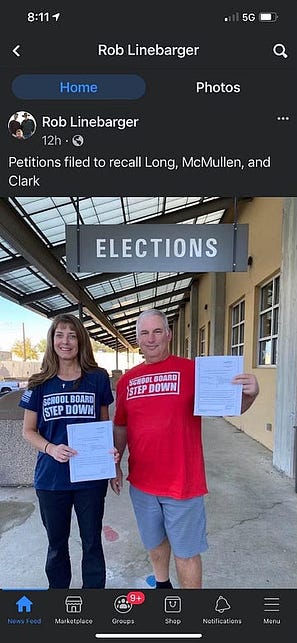Recalls, Christian nationalism, and David Barton’s revisionist U.S. history
The Central Valley School District (CVSD) Board of Directors (like many school boards across the country) is still under attack by folks whose prime motivation stems from the anti-mask, anti-vaccine-mandate, Covid conspiracy theorists who attacked school board members in the lead-up to the 2021 school board elections. In 2021 the name that kept popping up was Rob Linebarger. Mr. Linebarger presented himself as a candidate for the CVSD Board of Directors in 2021, ultimately stepping back to help Pam Orebaugh gain a seat on the five member board. This November three allied candidates, Anniece Barker, Jeff Brooks, and Stephanie Jerdon are the next wave ideological candidates in the ongoing effort to wrest majority control of the board from long-serving, experienced, and knowledgeable Directors Keith Clark, Debra Long, and Cindy McMillan.
Rob Linebarger continues to work with dogged determination toward a takeover of the CVSD Board of Directors even as he pops up elsewhere in support of the Christian nationalist ideologues allied with Matt Shea who now exert control over the Spokane County Republican Party. (The latest in that story is reserved for another day.)
Christian nationalism denies the separation of church and state specified in the First Amendment. Instead, Christian nationalists yearn to meld their particular understanding of Christianity with national and local government and insist this is justified by the claim that the U.S. was founded as an expressly Christian nation.
Background
In the elections of 2021, in mid-Covid pandemic, three anti-mask, anti-vaccine-mandate candidates ran in the primary for the open seat in Position 5 on the five member CVSD Board of Directors. Two allies, Pam Orebaugh and Rob Linebarger, advanced to the November general election. Facing a strong, last minute, write-in challenge by retired Central Valley teacher and coach Stan Chalich, Mr. Linebarger made an effort to direct his supporters to vote for Ms. Orebaugh instead. Ms. Orebaugh won by a small margin over Stan Chalich (who garnered more votes than Mr. Linebarger). The marginswere remarkable, since to vote for Stan Chalich required remembering and writing in his name on the ballot. Had the Orebaugh/Linebarger votes split evenly between them, Chalich would have won by a small margin. (Orebaugh’s position as a CVSD Director doesn’t come up again until the 2025 elections.)
Pam Orebaugh and Rob Linebarger were not content with simply pursuing representation on the CVSD Board in the person of Ms. Orebaugh. They wanted (and want) majority control. On October 8, 2021, a month before the general election was even held, Linebarger and Orebaugh mounted a recall campaign against three of the remaining four CVSD Board Directors, Keith Clark, Debra Long, and Cindy McMullen, in an attempt to gain a controlling majority on the Board. Here they are:

In the State of Washington (unlike Idaho) in order to get a recall election on the ballot one must specifically cite the charge(s). Once the charges(s) are written up by the specified official, the person or persons mounting the recall “shall petition the superior court [of the county] to approve the synopsis and to determine the sufficiency of the charges.” That last step is where Linebarger failed—at a necessary step before he and his allies could even start collecting signatures. “The petitions laid out about a dozen charges against each member, but were largely centered around statewide mask and vaccine mandates in public schools” [over which the CVSD Board had no legal discretion].
Spokane County Superior Court Judge Harold D. Clark dismissed all charges, calling them “factually and legally insufficient”, later adding that they were “politically motivated and frivolous”. Linebarger would not (and still has not) let it rest. The case (No. 2120289132) has generated a whopping 130 legal documents, the latest one just a week ago on October 6, 2023, related to an appeal filed by Linebarger, two years after he first filed the recall petition. His efforts have cost CVSD $175,000 in attorney’s fees as well as a vast investment of time by countless people at CVSD and in the judiciary (all at taxpayer expense) . Linebarger and his counsel have been sanctioned $30,000 by the Superior Court for his “bad faith” petition and his dogged persistence, $22,500 of that leveled against Linebarger personally—yet, ideologue that he is, he persists.
Who is Rob Linebarger and what makes him tick? He is the “9B [Legislative] District Leader” for the Spokane County Republican Party. He was a vocal disruptor of Central Valley School District Board meetings during the Covid pandemic. He established a 2021 political action committee called “Washington Citizens for Liberty 1st Amendment Protection Committee” that gathered $2,725.00 from precisely seven individual donors. The entire sum was given, on September 21, 2021, to the “charity” (i.e. a tax exempt 501(c)(3) that need not report the identity of its donors) named “Washington Citizens for Liberty” (click, then click “MENU” to explore) run by none other than—wait for it—Rob Linebarger. Washington Citizens for Liberty (aka Citizens4Liberty) consists of a flashy website that aggregates poorly referenced (mis)information that was last updated on August 14, 2022. The organization’s 2021 Form 990 [a required filing for a 501(c)(3)] shows that a total of $15,000 (three quarters of the revenue gathered that year from unnamed donors) went to the Wolf Law Group and the Crago Law Office, presumably spent on Linebarger’s endless (and ongoing) quest to recall three members of the CVSD Board of Directors (discussed above). Consider that—tax free donations spent harassing school board members. This isn’t the image of a “charity” I was taught…
Mr. Linebarger is also the author of a lengthy September 15, 2023 “Guest Opinion” in the Spokesman entitled “Plan to censure mayor an assault on all Christians”. In the “Guest Opinion” Linebarger bizarrely quotes scripture in an attempt to equate “Pastor” Matt Shea’s fringe interpretation of the Christian message as an ideology worthy of defense by all who identify as Christian. Even more bizarrely, he writes:
Psalm 2, written over three millennia ago and summarized in the Founders Bible with the title “Why Do the Nations Rage?” and text “The modern hostility toward Christianity in America is unprecedented, but the conflict is not new. Throughout history, those who hate God have joined forces with one another to oppose God, His Son, and His people.”
The Founders Bible??? The King James version and Revised Standard version are familiar, but “The Founders Bible”? That’s a new one—but an interesting rabbit hole to explore. The author of “The Founders Bible”, including the commentary about “those who hate God” quoted above, is David Barton, a man who has spent his life re-writing the history of the United States to align with his particular religious belief system. He is no historian. Barton’s education consists of a Bachelor of Arts degree in religious education from Oral Roberts University. He is an evangelical author and political activist for Christian nationalist causes. Barton has dedicated his life to re-writing history to convince anyone who will listen that the Founders were deeply religious Christians who established the United States as an exclusively “Christian nation”. Reputable historians, including conservative Christian historians, consider Barton’s work “pseudo-history”. It isn’t subtle. Barton has been caught offering quotes allegedly from Madison and Jefferson that have no basis in the primary literature. The “Accuracy” section of David Barton’s biography in wikipedia is well-referenced and scathing.
In spite of his tattered reputation among reputable historians, David Barton’s writings and speeches are widely admired and accepted by those anxious to promote the idea that Christians (of a particular stripe, i.e. Christian nationalists) should take over government at all levels and enact a biblically based legal system. It should come as no surprise then that “Barton has been praised by many American conservatives, such as Mike Huckabee, Newt Gingrich, Michele Bachmann, Sam Brownback, and Trinity Broadcasting Network president Matt Crouch”.
Is Linebarger even aware of David Barton’s quest to re-write history—or does Linebarger quote Barton’s words from the “Founders Bible” simply because the words bolster Linebarger’s ideology? Ideas have consequences whether or not one knows the origin the ideas.
Linebarger’s Spokesman “Guest Opinion” quoting from David Barton’s “Founders Bible” identifies Linebarger (with no further analysis) as:
Rob Linebarger, of Liberty Lake, is CEO of Washington Citizens for Liberty, a Washington State nonprofit that advocates for the protection of First Amendment rights. He is also a Republican precinct officer, subdistrict leader, and the Spokane County GOP Candidates Committee and Marketing Committee chair.
“Chief Executive Officer” of Washington Citizens for Liberty seems an undue glorification of a position in a tiny non-profit that appears to consist of nothing more than a glossy, out-of-date, misinformation website maintained by Mr. Linebarger himself.
Try to keep all this in mind, especially if you live in the Central Valley School District, as you contemplate the ballot you will receive next week. Vote for experience. Keep the stable, long-serving CVSD Board Directors Keith Clark, Debra Long, and Cindy McMillan.
Keep to the high ground,
Jerry

